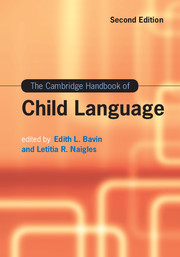Book contents
- The Cambridge Handbook of Child Language, second edition
- Cambridge Handbooks in Language and Linguistics
- The Cambridge Handbook of Child Language
- Copyright page
- Contents
- Figures
- Tables
- Contributors
- Book part
- 1 Introduction: perspectives on child language
- Part One Theoretical and methodological approaches
- Part Two Early developments
- Part Three Phonology, morphology and syntax
- Part Four Semantics, pragmatics and discourse
- Part Five Varieties of development
- Part Six Reading
- References
- Index
- References
Part One - Theoretical and methodological approaches
Published online by Cambridge University Press: 05 November 2015
- The Cambridge Handbook of Child Language, second edition
- Cambridge Handbooks in Language and Linguistics
- The Cambridge Handbook of Child Language
- Copyright page
- Contents
- Figures
- Tables
- Contributors
- Book part
- 1 Introduction: perspectives on child language
- Part One Theoretical and methodological approaches
- Part Two Early developments
- Part Three Phonology, morphology and syntax
- Part Four Semantics, pragmatics and discourse
- Part Five Varieties of development
- Part Six Reading
- References
- Index
- References
- Type
- Chapter
- Information
- The Cambridge Handbook of Child Language , pp. 13 - 134Publisher: Cambridge University PressPrint publication year: 2015



